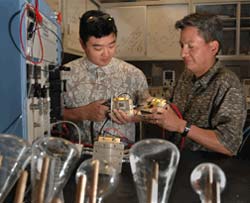This topic covers issues related to energy generation, conversion, transportation and consumption and how the industry is addressing the challenge of energy efficiency in general.
innovations-report provides in-depth and informative reports and articles on subjects ranging from wind energy, fuel cell technology, solar energy, geothermal energy, petroleum, gas, nuclear engineering, alternative energy and energy efficiency to fusion, hydrogen and superconductor technologies.

Like the signals it emits, the radio may soon disappear from sight.
University of Florida electrical engineers have installed a radio antenna less than one-tenth of an inch long on a computer chip and demonstrated that it can send and receive signals across a room. The achievement is another step in the team’s continuing efforts to build an “ultrasmall radio chip” – a transceiver, processor and battery all placed on a chip not much larger than a pinhead – and one that could one

Using improved processing equipment developed with support from the National Institute of Standards and Technology’s Advanced Technology Program, American Superconductor Corporation (AMSC) has produced lengths of record-breaking high-temperature superconductor (HTS) wire.
The company recently announced that it achieved electric current carrying capacity in multiple 10-meter lengths of second-generation (2G) HTS wire equal to or better than 250 Amperes per centimeter of width, an indust

A new type of polymer electrolyte membrane (PEM) is being developed by researchers at the Department of Energy’s Sandia National Laboratories to help bring the goal of a micro fuel cell closer to realization using diverse fuels like glucose, methanol, and hydrogen.
This Sandia Polymer Electrolyte Alternative (SPEA) could help fulfill the need for new, uninterrupted autonomous power sources for sensors, communications, microelectronics, healthcare applications, and transportation.

The largest single research project into solar power ever funded by the UK research councils was launched this month and could help make the energy source much more widely used in Britain.
The University of Bath is among six universities and seven companies in the UK that began the £4.5 million project this month (April) to halve the cost of converting the sun’s rays to electricity using solar cells.
The four-year research project could make solar power a viable alternative to

Scientists have demonstrated, for the first time, that transistors made from single-walled carbon nanotubes can operate at extremely fast microwave frequencies, opening up the potential for better cell phones and much faster computers, perhaps as much as 1,000 times faster.
The findings, reported in the April issue of Nano Letters, a peer-reviewed journal of the American Chemical Society, the world’s largest scientific society, add to mounting enthusiasm about nanotechnology’s rev

Researchers at the Department of Energy’s Pacific Northwest National Laboratory are developing a system to rapidly produce hydrogen from gasoline in your car. “This brings fuel cell-powered cars one step closer to the mass market,” said Larry Pederson, project leader at PNNL. Researchers will present their developments at the American Institute for Chemical Engineers spring meeting in New Orleans, on April 27th, 2004.
Fuel cells use hydrogen to produce electricity which runs the vehicle